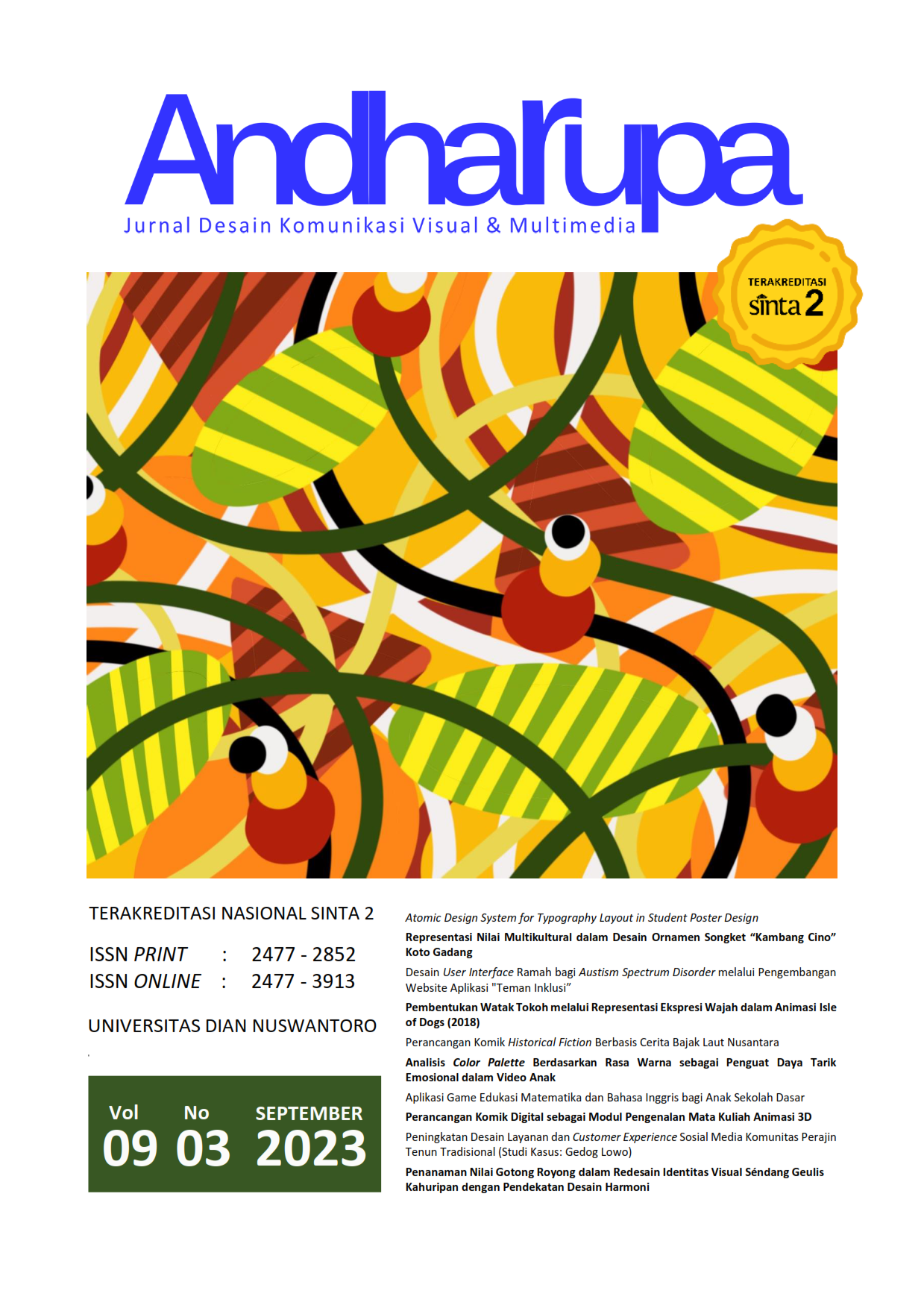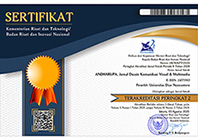Perancangan Komik Digital sebagai Modul Pengenalan Mata Kuliah Animasi 3D
DOI:
https://doi.org/10.33633/andharupa.v9i03.7186Abstract
AbstrakAnimasi merupakan salah satu cabang seni yang memiliki peran di banyak aspek kehidupan, mulai dari bisnis, hiburan hingga pendidikan. Besarnya prospek animasi di dunia industri menjadikannya sebagai salah satu mata kuliah untuk program studi Pendidikan Komputer. Dalam proses pembelajaran animasi sendiri diperlukan berbagai media yang dapat menunjang kemampuan praktek dan kreativitas mahasiswa, salah satu caranya adalah dengan memanfaatkan Digital Storytelling. Digital storytelling kemudian diterapkan ke dalam modul dengan format komik digital yang masih digemari di kalangan mahasiswa. Perancangan komik digital ini dilakukan menggunakan metode Research and Development (R&D) yang dikaitkan dengan pendekatan narasi visual. Penelitian dilakukan dengan tahapan: 1) Tahap riset dan pengumpulan informasi melalui pembagian kuisioner minat kepada mahasiswa untuk tahap testing, 2) Tahap perencanaan melalui perancangan komik digital berdasarkan hasil kuisioner tersebut, 3) Membagikan hasil rancangan berupa komik kepada mahasiswa, 4) Membagikan kuisioner tanggapan terhadap komik digital yang telah dibuat, dan 5) Menganalisis hasil kuisioner tanggapan. Penelitian menghasilkan modul dalam format komik digital, dan hasil kuisioner menunjukan adanya antusiasme mahasiswa terhadap modul berbasis komik untuk belajar animasi 3D. Kata Kunci: animasi, edukasi, digital storytelling, komik, modul AbstractAnimation is a branch of art which plays a role in many aspects of life, from business, entertainment to education. The huge prospect of animation in the industrial world makes it one of the subjects for the Computer Education study program. In its learning process, various media are needed to support students' practical abilities and creativity, and to do so, using digital storytelling. The digital storytelling aspect is then applied to a digital comic-formatted module which is popular among students. Designing the digital comics was carried out using the Research and Development (R&D) method combined with visual-narration approach. This research is conducted with several stages such as 1) Research and information collection is done by distributing questionnaires to students 2) Planning and designing digital comics based on the results of the questionnaire 3) Distributing the digital comic among the student as testing phase 4) Conducting questionnaires in response to the digital comic that have been made 5) analyze the result of the questionnaire. This research produced a module in digital comic format, and the results of the questionnaire showed the enthusiasm of students towards comic-based modules for learning 3D animation. Keywords: animation, comic, digital storytelling, education, moduleReferences
Dewi, N. I. K., Saraswati, A., & Furqon, A. N. F. (2022). Penerapan Pola Komunikasi Soft Selling melalui Storytelling dalam Film Iklan “Metamorfodream”. ANDHARUPA: Jurnal Desain Komunikasi Visual & Multimedia, 8(02), 231-245.
Fadilla, A. N., & Aditia, P. (2022). Storytelling Dalam Kemasan Kopi Janji Jiwa. ANDHARUPA: Jurnal Desain Komunikasi Visual & Multimedia, 8(01), 1-9.
Gürsoy, G. 2021. Digital storytelling: developing 21st century skills in science education. European Journal of Educational Research, 10(1), 97-113.
Redman, P. 2006. Good essay writing: a social sciences guide. 3rd ed. London: Open University in assoc. with Sage.
Gustiani, S. (2019). Research and development (R&D) method as a model design in educational research and its alternatives. Holistics (Hospitality and Linguistics): Jurnal Ilmiah Bahasa Inggris, 11(2).
González-Zamar, Mariana-Daniela & Abad-Segura, Emilio & Rosa, Antonio & Meneses, Eloy. 2020. Digital Education and Artistic-Visual Learning in Flexible University Environments: Research Analysis. Education Sciences. 10. 294.
Hanif, Wildan & Rachminingsih, Irma. 2020. Designing Comic Book as a Medium for Learning Tenses and Aspect in English.
Jee, B. D., & Anggoro, F. K. (2012). Comic cognition: exploring the potential cognitive impacts of science comics. Journal of Cognitive Education and Psychology, 11(2), 196-208.
Lucena Rodríguez, Carmen & García-Jiménez, Marta & Massó, Belén & Cruz-González, Cristina. 2021. Digital Storytelling in Education: A Systematic Review of the Literature. Review of European Studies. 13. 13.
McCloud, S. 1994. Understanding Comics. William Morrow Paperbacks.
Palioura, Maria & Dimoulas, Charalampos. 2022. Digital Storytelling in Education: A Transmedia Integration Approach for the Non-Developers. Education Sciences. 12. 559.
Pasfield-Neofitou S. E. Sell C. & Chan Q. 2016. Manga vision: cultural and communicative perspectives. Monash University Publishing (Online) URL: http://www.oapen.org/download/?type=document&docid=645347 [Diakses pada 3 Desember 2022]
Robin, Bernard. 2016. The Power of Digital Storytelling to Support Teaching and Learning. Digital Education Review. 30. p. 17-29.
Saputro, G. E., Haryadi, T., & Yanuarsari, D. H. (2016). Perancangan purwarupa komik interaktif safety riding berkonsep digital storytelling. ANDHARUPA: Jurnal Desain Komunikasi Visual & Multimedia, 2(02), 195-206.
Suwardy, Themin & Pan, Gary & Seow, Poh-Sun. (2013). Using Digital Storytelling to Engage Student Learning. Accounting Education. University in assoc. with Sage.
Zagkotas, Vasileios. 2018. Are comic books appropriate for teaching History? Three suggestions for Greek Primary Education, Education p. 3-13
Downloads
Published
Issue
Section
License
Authors who publish with this journal agree to the following terms:
- Authors retain copyright and grant the journal right of first publication with the work simultaneously licensed under a Creative Commons Attribution License that allows others to share the work with an acknowledgment of the work's authorship and initial publication in this journal.
- Authors are able to enter into separate, additional contractual arrangements for the non-exclusive distribution of the journal's published version of the work (e.g., post it to an institutional repository or publish it in a book), with an acknowledgment of its initial publication in this journal.
- Authors are permitted and encouraged to post their work online (e.g., in institutional repositories or on their website) prior to and during the submission process, as it can lead to productive exchanges, as well as earlier and greater citation of published work (See The Effect of Open Access).















